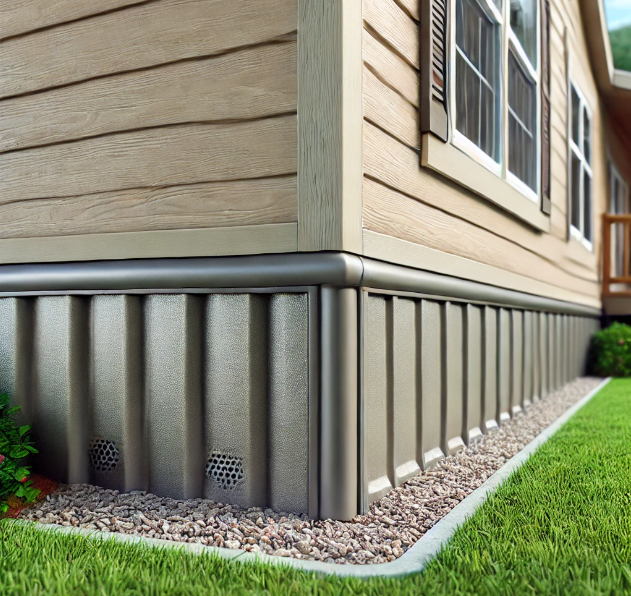
If you own or are planning to purchase a mobile or manufactured home, you might wonder if skirting is necessary or an optional addition that you can do without. This guide aims to help you make an informed decision by providing must-know details about mobile home skirting, its benefits, and the types available. We also offer installation tips if you do decide to purchase skirting for your home.
What Is Mobile Home Skirting, and Why is it Important?
A mobile or manufactured home is built on a chassis, a metal frame that allows it to easily transport to different locations. A typical unit has at least 12 inches of clearance between the ground and the chassis.
So, what is mobile home skirting? Essentially, it is a barrier installed around the base of a mobile home to enclose this space. Besides enhancing the home’s appearance, skirting a mobile home also provides multiple functional benefits that improve its durability and efficiency. These include:
- Pest Protection: Skirting blocks rodents, insects, and other animals from entering the underside of the home. By sealing off this space, skirting prevents these pests from damaging components such as wiring, plumbing, and insulation. This can help homeowners avoid expensive repairs and costly pest control services.
- Weather Protection: Skirting shields the area under the home from harsh weather conditions, reducing its exposure to wind, rain, and temperature fluctuations. This minimizes moisture buildup, helps keep pipes from freezing, and guards against water damage to the home’s foundation and structure.
- Energy Savings: Skirting acts as an insulating layer for a mobile home, reducing drafts and helping maintain a stable indoor temperature. By minimizing heat loss in winter and reducing heat gain in summer, skirting a mobile home can significantly lower heating and cooling costs, making the home more energy-efficient.
- Enhanced Structural Stability: Skirting a mobile home increases stability by reducing moisture buildup in the space beneath it. This helps prevent foundation damage, plumbing corrosion, and mold growth, all of which can compromise the home’s integrity over time.
- Improved Aesthetic Appeal: Skirting, if properly installed and in good condition, gives a mobile home a polished, finished appearance. As such, it boosts curb appeal and can even positively impact the home’s resale value.
With these benefits, quality skirting not only supports a mobile home’s longevity but also enhances its comfort, energy efficiency, and appearance, making it a worthy investment for homeowners.
Types of Mobile Home Skirting
There are various skirting materials and styles available. When searching for the best skirting ideas for mobile homes, consider options that align with your climate, budget, and maintenance preferences to find a solution that protects and complements your home. The following are some of the most popular mobile home skirting options, as well as their pros and cons:
Vinyl Skirting
Many homeowners prefer vinyl skirting because it is affordable and lightweight. It’s also available in a wide range of colors, is easy to install, and requires little maintenance.
Vinyl skirting is best for mobile homes in mild or temperate climates, as it provides little insulation. Additionally, it is susceptible to damage caused by punctures and impact.
Faux Brick or Stone Skirting
This type of mobile home skirting is typically made from either vinyl or polyurethane. It is designed to mimic the look of real brick or stone. It is generally more resilient than traditional vinyl skirting, with some manufacturers offering weather- and decay-resistant mobile home skirting options.
While faux brick or stone skirting is less expensive than masonry or stone, it tends to cost more than conventional vinyl siding. Additionally, homeowners would likely need professional assistance to set it up, as it is heavy and requires special installation techniques.
Metal Skirting
Durable and sturdy, metal skirting offers reliable protection against pests and can withstand harsh weather conditions. It is typically made of galvanized steel or aluminum. With minimal upkeep, it can last for many years longer than vinyl skirting.
Metal skirting is highly resistant to damage from impact, pests, and moisture. Additionally, since it’s made of metal, it’s non-combustible. However, it isn’t as aesthetically pleasing as vinyl or other mobile home skirting options, and it can be noisy during windy weather.
Concrete Skirting
Concrete skirting is a durable and low-maintenance option that provides excellent insulation. Ideal for extreme climates, it offers high resistance to moisture, wind, and temperature changes. However, concrete skirting is heavy and requires professional installation due to its weight and structural demands.
Foam-Insulated Panels
Foam-insulated panels are a top choice for superior insulation. They help regulate temperature by keeping the area beneath the home warmer in winter and cooler in summer.
Though they are more costly, foam-insulated panels are an excellent investment in extreme climates where maintaining a stable temperature is essential. They’re also relatively easy to install.
Lattice Skirting
Lattice skirting is an affordable, visually appealing option that provides ventilation and a decorative touch to the home’s exterior. While it’s not as durable as other materials, it can be a good choice for homes in warmer climates where insulation and heavy-duty protection against pests and the elements aren’t primary concerns.
Exploring various skirting ideas for mobile homes can help you find the perfect balance between durability, insulation, and aesthetic appeal.
Installation Tips for Mobile Home Skirting
When researching manufactured home skirting ideas, keep in mind that all types of skirting require careful and precise installation. It requires meticulous planning and attention to detail to ensure it provides lasting protection and aesthetic appeal.
Proper installation not only helps the skirting function as intended but also minimizes the need for future repairs or adjustments. By following a few key steps and using quality materials, you can ensure your skirting performs its job well and enhances your home for years to come.
Here are some essential tips to guide you through the installation process.
- Measure Carefully: Accurate measurements are critical to a successful skirting installation. Start by measuring the height from the ground to the base of your mobile home and the full perimeter. These precise dimensions ensure each panel fits well, preventing gaps and improving insulation.
- Prepare the Ground: Before installing skirting, it’s essential to clear and level the ground around the home’s base. Removing rocks, roots, and other debris creates a stable, even surface that minimizes shifting or settling in the future. A level foundation for your skirting supports a neat, long-lasting installation.
- Add Ventilation: Installing vents in your skirting allows airflow beneath the home, crucial for reducing humidity and preventing mold or mildew. Proper ventilation protects your home’s foundation and maintains interior air quality by limiting moisture buildup. Position vents evenly for balanced air circulation.
- Choose Proper Fasteners and Tools: Durable, rust-resistant fasteners like stainless steel nails or coated screws keep skirting securely in place. Quality materials withstand storms and seasonal changes, reducing the need for frequent maintenance. Investing in reliable fasteners from the start saves time and preserves the skirting’s stability.
- Seasonal Adjustments: In regions with cold winters, consider adding insulated panels to reduce drafts and help prevent freezing. Regularly inspecting skirting for damage, especially at season changes, helps catch any early issues, such as cracks or loose panels. Seasonal adjustments ensure that the skirting stays effective in all weather conditions.
- Ensure Proper Drainage: Sloping the ground slightly away from your home directs water runoff away from the skirting, reducing the risk of moisture damage, mold, and erosion. Proper drainage preserves the skirting and your home’s foundation by keeping water from pooling near the structure.
- Secure Bottom Edges: Anchoring the bottom of your skirting with ground spikes, bricks, or a track system provides extra stability. This reinforcement prevents panels from lifting or shifting in strong winds, keeping your skirting intact and secure in all conditions.
Maintenance and Care: Mobile Home Skirting Ideas
Maintaining your mobile home skirting can help prolong its lifespan. Here are a few tips to help keep it in good condition:
- Regular Inspections: Examine the skirting at least twice a year, checking for signs of cracks, warping, or other damage. Routine inspections help you spot issues early before they become larger problems.
- Cleaning Tips: Different materials require different cleaning methods. Vinyl and metal skirting, for example, can be cleaned with a mild soap and water solution to remove dirt and stains, keeping them looking fresh and well-maintained.
- Repairing Damage: Minor issues, such as small cracks in vinyl or loose panels, can often be patched or reinforced with adhesive or additional fasteners.
Choosing the Right Skirting for Your Mobile Home
Selecting the best skirting option depends on various factors, from climate and budget to aesthetic preferences.
Here are a few considerations to keep in mind:
- Budget: Compare the costs of different materials, factoring in the price of the skirting itself and any installation-related expenses. Vinyl, faux stone or brick, and lattice skirting are typically more affordable, while concrete, metal, and foam-insulated panels cost more but offer superior durability and insulation.
- Climate Suitability: The climate in your area affects which skirting material will work best. For example, vinyl and lattice are better suited for mild climates, while foam-insulated and concrete skirting are ideal for extreme temperatures and high winds.
- Aesthetic Preferences: Look for colors, textures, and styles that complement your home’s exterior. Matching the skirting to your home’s siding creates a cohesive appearance that enhances curb appeal.
- Ease of Installation: Consider whether you prefer DIY installation or professional help. Vinyl, lattice, and foam-insulated panels are often easier for homeowners to install, while concrete and metal may require a professional’s help.
Investing in quality mobile home skirting can significantly improve your home’s comfort, protection, and energy efficiency. By choosing the right materials, following proper installation practices, and keeping up with regular maintenance, you can ensure that your skirting provides lasting benefits.
Shop for Mobile Home Skirting and Supplies at Basic Components Inc.
High-quality mobile home skirting is an investment that pays off through enhanced curb appeal, improved energy efficiency, and reliable protection against pests and the elements.
At Basic Components Inc., we offer a wide selection of durable skirting materials and mobile home supplies designed to meet your needs, from adhesives and sealants to roofing and flooring products. With our extensive inventory, you can easily bring your manufactured home skirting ideas to life.
View our collection to find the best option for your home, and place your order today. You may also get in touch with us if you have any questions or need more mobile home skirting ideas.

